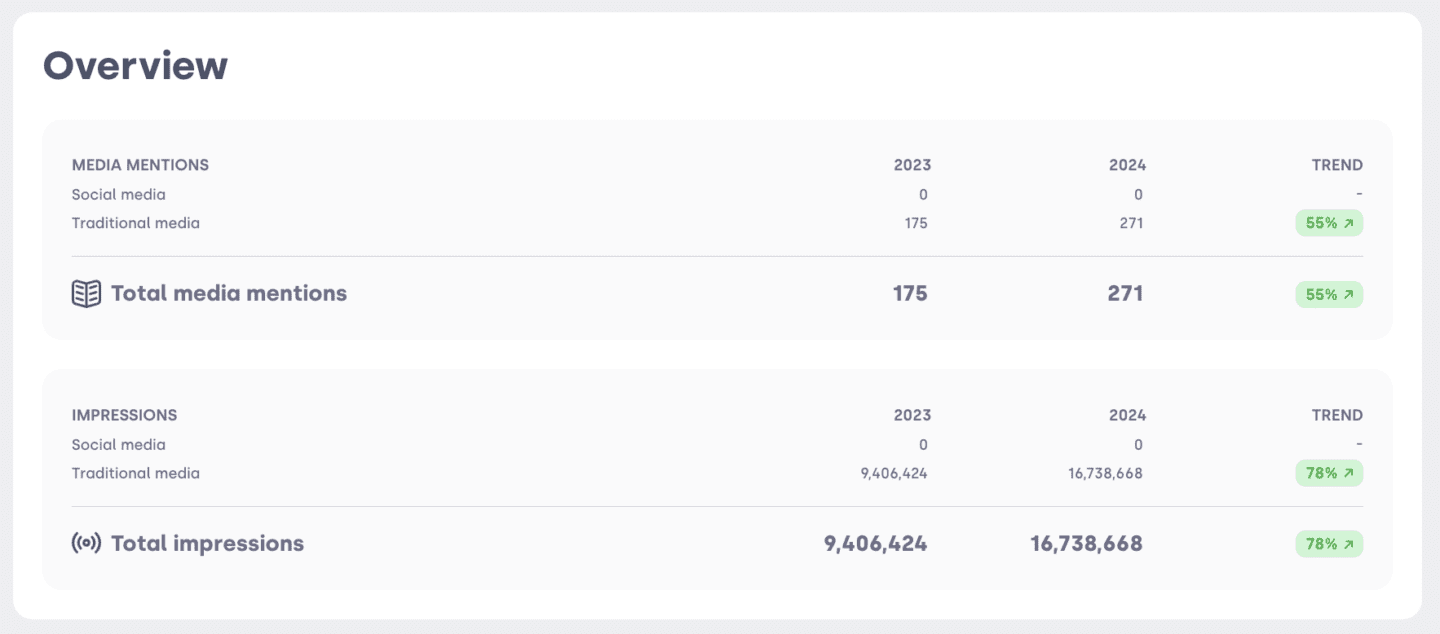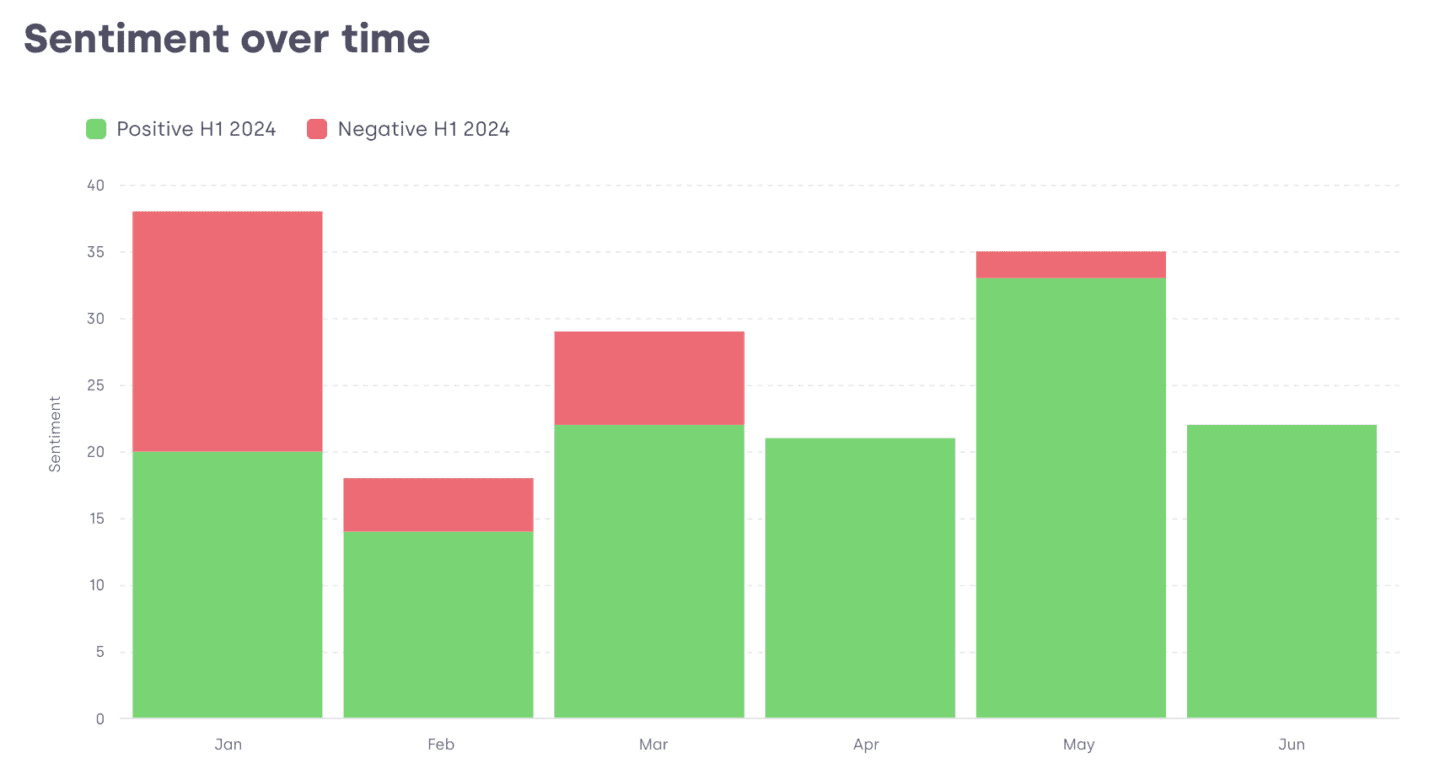Brand Analysis: Find Out How Your Brand Is Performing

A strong brand doesn’t happen by accident. It’s the result of your strategic decisions, continuous insights, and constant refinement. But how do you know if your brand truly resonates with your audience? That’s where brand analysis comes in. In this blog post, we’ll explore how to assess your brand’s performance and gather the insights you need to plan for growth.
When people talk about the need to work in a more data-driven way, this is what they mean—regularly analyzing your performance and using the insights gained for smarter decision-making.
For a long time, measuring brand performance was difficult and expensive. This includes understanding how the public perceives your brand, the ideas associated with it, and the financial value of media visibility. What marketing and communication professional hasn’t struggled to explain the monetary value of branding efforts?
Today, AI-powered tools can evaluate all of this in just minutes, giving you a complete view of your brand’s performance (and the opportunity to report the cherished ROI, Return on Investment, to the world).
Now, let’s explore how to conduct a brand analysis and what it should include to answer your questions effectively.
What Is a Brand Analysis?
A brand analysis is a report that evaluates your brand performance, strength, perception, and market position. It includes key brand and media metrics, data analysis, and conclusions.
It lets you:
- Benchmark your brand’s market presence and influence against competitors.
- Identify which communication activities are most effective and should be prioritized.
- Track the messages and campaigns that resonate best with your audience.
- Uncover market gaps and opportunities.
- Make informed, data-driven decisions to strengthen your brand.
How to Create a Brand Analysis
You have three main options for conducting a brand analysis:
- Do it yourself, manually.
- Hire an agency.
- Do it yourself, using an AI-powered software.
Digital tools, like Mynewsdesk’s Brand Report, allow you to generate reports on-demand, benchmark against competitors, and easily share insights with the rest of your organization.
Whichever method you choose, your analysis must answer the critical questions you’ve identified about your brand’s performance.
What to Include in Your Brand Analysis (And Why)
Data reports can be complex, so you want to make sure that your brand analysis is easy for all colleagues to understand.
Along with performance metrics, include easy-to-read charts and graphs that show trends. For each section of your report, add a summary of key findings and the practical recommendations for improvement.
Here are the recommended sections to include in your brand analysis:
1. Key Metrics
Essential metrics to track in order to understand your brand’s visibility and public perception include Media Mentions, Impressions, Net Sentiment Score, Share of Voice, and Ad Value. Be sure to include them in the summary at the beginning of your report.

In Mynewsdesk’s Brand Report tool (available for free trials in Sweden, Norway, and Denmark), the key metrics summary appears at the start of the brand analysis.
Media Mentions
Count the number of times your brand is mentioned across news sites, blogs, and social media to evaluate whether your market presence is strong or weak.
Impressions
Track the reach of these brand mentions to assess your brand’s visibility.
Net Sentiment Score
Analyze the public sentiment—are the brand mentions positive, neutral, or negative?
Share of Voice
Compare the percentage of media coverage your brand receives to your competitors to see how much of the industry conversation is focused on your brand.
Ad Value
Estimate the value of earned media visibility by calculating the potential cost of achieving the same visibility through paid native ads. You can calculate ad value using either Cost per Mille (CPM) or Cost per Contact (CPC). Digital brand analysis tools do this automatically.
2. Brand Visibility and Media Analysis

Increase/decrease in brand visibility, measured by media mentions across channels and impressions.
Media Mentions
Assess where and how often your brand is mentioned across various channels, including traditional and social media. The most efficient way to track the instances where your brand appears is by utilizing a media monitoring tool. Mynewsdesk’s Brand Report and Coverage Report include this feature.
Total Impressions
Track how often your content is viewed by your audience across media types, from news articles to social media posts.
Key Themes and Topics
Use AI to identify the key themes and topics related to your brand, ensuring that your marketing efforts resonate with consumer interests. An AI-powered brand analysis tool generates this information automatically.
Types of Media
Differentiate the types of media where your brand is mentioned to understand how visibility across various platforms affects your overall presence. Where do you gain the most engagement? Which media types generate the most mentions, and what is their positive or negative impact on your brand?
Highlights
Be sure to include examples of the publicity your brand has received, such as URL links, article thumbnails, or clips.

Examples of media coverage highlights are suggested automatically by Mynewsdesk’s Brand Report tool.
3. Brand Visibility Benchmarking
Share of Voice
Compare your brand’s visibility to that of competitors by measuring the percentage of media coverage. This metric indicates your brand’s market influence and can be calculated by your brand analysis tool.
Share of Voice over time
Track how your Share of Voice changes, particularly after key campaigns or events, to understand what influences visibility. This section is best presented with a graph that illustrates trends over the past 3, 6 or 12 months, comparing your brand to competitors.

What did you do in May that your competitors didn’t?
4. Brand Perception
Beyond your logo and tagline, your brand represents the emotional and psychological connection you share with your audience. To nurture this relationship and understand which efforts resonate the most, you need a clear picture of your brand’s performance.
Examine the emotions and opinions expressed about your brand by evaluating sentiment. This analysis provides valuable insights into public perception and helps you manage your reputation and prioritize your marketing activities.
Sentiment Overview
Classify your brand mentions as positive, neutral, or negative to assess public perception.
Sentiment Over Time
Analyze how sentiment fluctuates throughout the year. Did a product launch or campaign spike positive (or negative) mentions?

Brand sentiment has improved over the past 6 months, from somewhat negative in January to only positive in June.
5. Benchmarking
Sentiment Comparison
Compare your brand’s sentiment to your competitors to identify relative strengths and weaknesses.
This analysis highlights your brand’s performance in terms of visibility, trust, and overall sentiment, providing a clearer understanding of how it stacks up in the market.
Summary
Key points for a brand analysis highlighted in this blog post include:
- Purpose: Get valuable insights to drive growth and improve brand perception.
- Key Metrics: Focus on Media Mentions, Impressions, Share of Voice, and Net Sentiment Score.
- Critical Questions: Assess competitive positioning and audience connection.
- Benefits: Informed decision-making and stronger audience relationships through regular updates.
Remember to do this regularly. Brand analysis isn’t a one-time task; it’s an ongoing process. Regularly generate updated brand analyses—monthly, quarterly, biannually, and/or annually—to stay aligned with your audience’s needs and remain competitive.
Create Your Free Brand Report!
Get these insights in just minutes with Mynewsdesk’s tool Brand Report! Simply enter your brand name, generate your free report, and start planning for growth. The report is easy to read, export, and share—powered by one of the market’s most advanced AI models.
Create Your Free Brand Report (Sweden)
Create Your Free Brand Report (Norway)
Create Your Free Brand Report (Denmark)
Good luck!